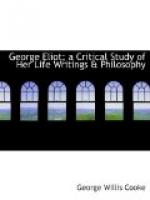George Eliot has not attempted a great variety in the use of dialect, for she has avoided unfamiliar words, and has made use of no expressions which would puzzle her readers in the attempt to understand them. The words not to be found in the dictionary are those which may in almost every instance be heard in the speech of the uncultured wherever the English language is spoken. Among others are these words: chapellin’, chanch, coxy, corchey, dawnin’, fettle, franzy, gell, megrim, nattering, nesh, overrun, queechy, plash. In a letter to Professor Skeats, published in the Transactions of the English Dialect Society, she has explained her methods of using dialect.
It must be borne in mind that my inclination to be as close as I could to the rendering of dialect, both in words and spelling, was constantly checked by the artistic duty of being generally intelligible. But for that check I should have given a stronger color to the dialogue in Adam Sede, which is modelled on the talk of North Staffordshire and the neighboring part of Derbyshire. The spelling, being determined by my own ear alone, was necessarily a matter of anxiety, for it would be as possible to quarrel about it as about the spelling of Oriental names. The district imagined as the scene of Silas Marner is in North Warwickshire; but here, and in all my other presentations of English life except Adam Bede, it has been my intention to give the general physiognomy rather than a close portraiture of the provincial speech as I have heard it in the Midland or Mercian region. It is a just demand that art should keep clear of such specialties as would make it a puzzle for the larger part of its public; still, one is not bound to respect the lazy obtuseness or snobbish ignorance of people who do not care to know more of their native tongue than the vocabulary of the drawing-room and the newspaper.
It may be said of George Eliot’s realism that she did not borrow nearly so much from actual observation as was done by Charlotte Bronte, in whose novels, scenes, persons and events are described with great accuracy and fulness. In large measure Charlotte Bronte borrowed her materials from the life about her. Large as was her invention, original as her mind was, and unique in its thought, yet she seems to have been unable to create the plots of her novels without aid from real events and persons. Persons and scenes and events were so vividly portrayed in Jane Eyre as to be at once recognized, subjecting the author to much annoyance and mortification. In Shirley there is even a larger use of local traditions and manners, the locality of the story being described with great accuracy. George Eliot did not use such materials to nearly so great an extent, being far less dependent on them. Nor had she anything of Scott’s need of local traditions. Accurate as she is, she creates her own story, not depending, as he did, on the suggestive help of the




